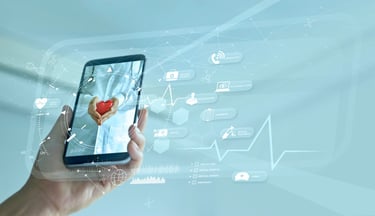
Where are Chat and Voice Solutions Headed in 2021? Predictions by Orbita CEO Bill Rogers
Read original Dec. 15 article in Health IT Outcomes
As 2020 draws to a close, we can safely say this year was filled with monumental changes: some bad and some good. Alongside the environmental and biological catastrophes, we witnessed a political transformation, the evolution of various social movements, and the accelerated advancement of technology. Digital solutions have rapidly adapted to fill many of the gaps created by social distancing and the increased need for connection and communication.
One example is Orbita's COVID-19 Vaccine Clinical Access Program that developed to support vaccine administration and address patient apprehension and concerns. This program expands digital front door initiatives to include vaccine eligibility screening, vaccine scheduling, and post-vaccination monitoring programs.
The unprecedented events of this year have particularly elevated the role of chat and voice solutions in the healthcare context. These tools are designed to enhance communication and deliver more control and knowledge directly into the hands of patients. Through the pandemic, chat and voice solutions have reduced administrative burdens on healthcare providers and supported the delivery of a holistic care experience.

Where will these solutions go next? and what is in store for the future of AI?
In the next year, there will be numerous improvements to and expansions of chat and voice solutions, which will cement their role in the healthcare IT landscape.
1. The Integration Of Biomarkers
One of the prominent obstacles with tech adoption is the robotic nature of digital solutions, specifically their lack of empathy. In healthcare, patients want their fears and concerns validated and quelled, which is not easy to accomplish without a natural understanding of emotions and intuition. The integration of biomarkers in devices that communicate with humans will be a major step towards Automation with Empathy™.
2. Augmenting Remote Patient Monitoring
With the transition to patient-centric care, more emphasis is placed on remote patient monitoring systems and ensuring the care cycle is continuous. The incorporation of chat and voice solutions in remote patient monitoring programs provides a real-time connection between patients and providers. Particularly, wearable devices and interactive smart speakers make collecting and tracking vitals easier for people with varying levels of comfort with technology.
3. The 5th Generation Technology Standard (5G)
The telemedicine market is expected to grow at a compound annual growth rate of 16.5% from 2017 to 2023. As many people progress with the telehealth movement, specific populations are left behind; particularly, low-income communities and rural populations.
5G offers increased bandwidth and higher speeds to most phones and devices. Leveraging this network’s capabilities for chat and voice solutions in the healthcare space could deliver even more proactive and continuous patient care. With a broader reach, more patients and providers will have remote access to each other. Even further, 5G is ushering in a new era of IoT with a low bandwidth cost-saving option that will be used in the next generation of home medical devices used to track vitals such as blood pressure, weight, glucose meter, blood oxygen, and sleep.
4. Expansion Of Symptom Checkers
A niche aspect of remote patient monitoring is checking symptoms. In the past year, targeted symptom checkers have emerged to assess a patient’s likelihood of a COVID-19 infection. There are some concerns regarding the effectiveness of care suggestions independently made by virtual assistants, but virtual symptom checkers will likely be more widely adopted in the next year. Perhaps several years from now, there will be a scenario in which a chatbot can fully triage a patient’s symptoms by collecting information, relaying it back to a healthcare provider who would simply approve of the care plan, diagnosis, or give care suggestions. This could streamline the delivery of care and even prevent human or technical errors with a system of checks and balances.
5. AI As A Recommendation Engine
With a greater acceptance of technology adoption in healthcare, even more data will become available and support the use of AI as a recommendation engine. This consists of collecting patient context and returning relevant, suggested content. A healthcare organization that offers sleep therapy, for example, focuses on monitoring the quality of patients’ sleep and certain behaviors. AI enables the technology to independently determine when to deliver that information, how much, and which content. It could even make suggestions to the care provider to switch to a better care journey pathway.
This has the potential to significantly augment remote care and monitoring while arming patients with verified, personalized knowledge. Today, many chat and voice solutions offer expected communication, this capability would advance chatbots to the next level of intelligence and autonomy.  As we look to the future of AI-powered technology, what excites and empowers innovators is the uncapped potential for these solutions to improve communication, education, and the overall healthcare journey. As healthcare organizations prioritize the development of digital transformation strategies in the next year and beyond, they will be able to easily welcome innovation as it comes.
As we look to the future of AI-powered technology, what excites and empowers innovators is the uncapped potential for these solutions to improve communication, education, and the overall healthcare journey. As healthcare organizations prioritize the development of digital transformation strategies in the next year and beyond, they will be able to easily welcome innovation as it comes.



